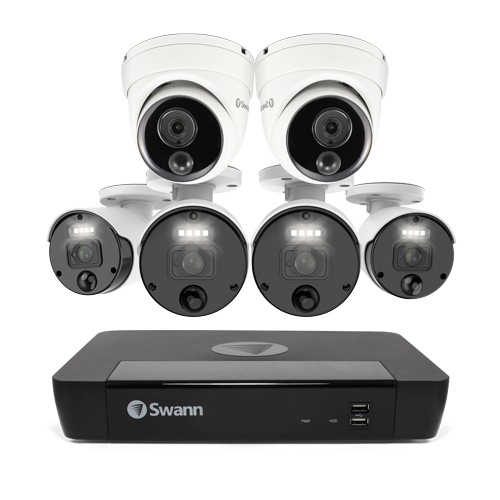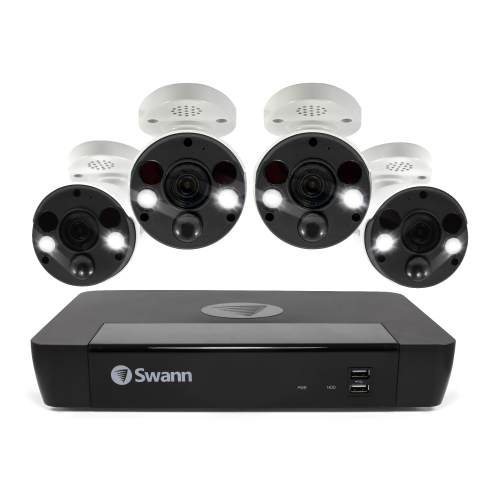Shop By
-

-

-

6 Camera 8 Channel 4K Master-Series NVR Security System | SONVK-876804B2D
$1,249.95Now: $899.9528% OFF -

-

-

-

-


Explore Swann's wide range of convenient, high-quality wired NVR security camera systems that will help keep intruders out & your property safe.









Wired NVR security systems use powerful internet protocol (IP) cameras, which can capture audio, provide facial recognition, and deliver superior video quality. The cameras connect to an NVR recorder box via Ethernet cable and the NVR provides power to each camera using Power over Ethernet (PoE). These cameras have the technology to process video data, instead of relying on the recorder to do it. Wired NVR surveillance systems have advantages over DVR systems, because the cameras are easier to install with superior digital video and NVRs typically have more smart AI features.
NVR (Network Video Recorder) systems use digital IP, or internet protocol, cameras, which process digital video and audio signals before transmitting them to the recorder. NVR cameras can be wired (using Ethernet cable) or wireless (transmitting video to the recorder via Wi-Fi). Wired NVR systems offer Power over Ethernet (PoE), conveniently providing power to each camera from the recorder via Ethernet cables.
DVR and NVR surveillance systems use different types of cameras, shaping how each system operates. DVR systems use traditional analog cameras, which have to be connected to the recorder through coaxial cables, creating a reliable but somewhat inflexible surveillance system.
NVR systems, on the other hand, use digital IP cameras, which process digital video and audio signals before transmitting them to the recorder. NVR cameras can be wired (using Ethernet cable) or wireless (transmitting video to the recorder via Wi-Fi). The digital IP cameras also provide higher resolution video than analog cameras, and frequently can offer more advanced features, such as face recognition.
Wired NVR systems are hardwired into the home, transmitting video and audio signals from the cameras to the recorder through Ethernet cables, with power to the cameras via PoE.
Powered Wi-Fi systems transmit signals through the home’s Wi-Fi network instead of using Ethernet cables, but the cameras still need to be plugged into a power source.
Wireless or Wire-free systems also transmit signals through the home’s Wi-Fi, but use rechargeable battery-powered cameras that don’t need to maintain a connection to a power source.
The number of cameras, or channels, that a recorder can support depends on the specific model. Swann NVR recorders can support anywhere from 4 to 16 channels.
The Swann Security app for iOS or Android allows you to access live or playback video wherever you are. NVR systems come with a hard drive to locally store (usually up to 4TB of) data. There is also the option to back up some of the camera footage on the cloud.
Swann NVR recorders have massive 1-4TB hard drives, allowing for footage to be stored for six months to one year at no additional cost to you.
You can permanently save images and video in your personal Dropbox account in the cloud, or transfer footage to a USB memory stick or hard drive for safekeeping.
No. There are no ongoing fees to install and operate your system and there is ample free local storage included with every Swann NVR.
Multi-stream wired surveillance systems typically require broadband internet connection at the premises where the cameras are located with upload bandwith of 2Mbps or greater.